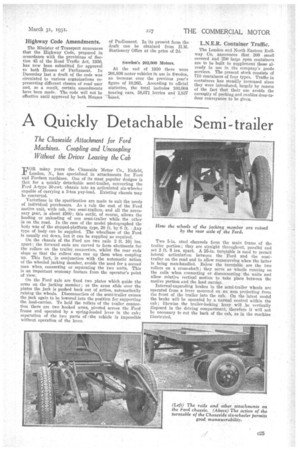A Quickly Detachable Semi-trailer
Page 47

If you've noticed an error in this article please click here to report it so we can fix it.
The Chaseside Attachment for Ford Machines. Coupling and Uncoupling Without the Driver Leaving the Cab
FOR many years the Chaseside Motor Co., Enfield, London, N., has specialized in attachments for Ford and Fordson machines. One of its most popular designs is that for a quickly detachable semi-trailer, converting the Ford A-type 30-cwt. chassis into an articulated six-wheeler capable of carrying a 3-ton pay-load. Existing chassis may be converted.
Variations in the specification are made to suit the needs of individual purchasers. As a rule the cost of the Ford motive unit, with cab, two semi-trailers, and all the necessary gear, is about f500; this outfit, of course, allows the loading or unloading of one semi-trailer while the other is on the road. In the case of the model photographed the body was of the stepped-platform type, 20 ft. by 6 ft. Any type of body can be supplied. The wheelbase of the Ford is usually cut down, but it can be supplied as required.
On the chassis of the Ford are two rails 2 ft. 10i ins. apart ; the forward ends are curved to form abutments for the rollers on the trailer connection, whilst the rear ends slope so that the rollers can run up them when coupling up. This fact, in conjunction with the automatic action, of the wheeled jacking &ember, avoids the need for a second man when, connecting or separating the two units. This is an important economy feature from the operator's point of view.
On the Ford axle are fixed two plates which guide the arms on the jacking member; aS the arms slide over the plates the jack is pushed back out of action, automatically raising the wheels. Disconnection of the semi-trailer causes the jack again to be lowered into the position for supporting the load-carrier. To hold the rollers of the trailer connection there are two hooked arms, pivoted across the Ford frame and operated by a spring-loaded lever in the cab; separation of the two parts of the vehicle is impossible without operation of the lever.
Two 5-in. steel channels form the main frame of the trailer portion; they are straight throughout, parallel and set 2 ft. 8 ins. apart. A 25-in, turntable is used to permit lateral articulation between the • Ford and the semitrailer on the road and to allow manceuvring when the latter is being man-handled. Below the turntable are the two rollers on a cross-shaft; they serve as wheels running on the rails when connecting or disconnecting the units and allow relative vertical motion to take place between the motive portion and the load carrier.
Internal-expanding brakes in the semi-trailer wheels are operated from a lever mounted on an arm projecting from the front of the trailer into the cab. On the latest model the brake will be operated by a normal control within the cab; likewise the trailer-locking lever will be vertically disposed in the driving compartment, therefore it will not be necessary to cut the back of the cab, as in the machine illustrated.












































































































